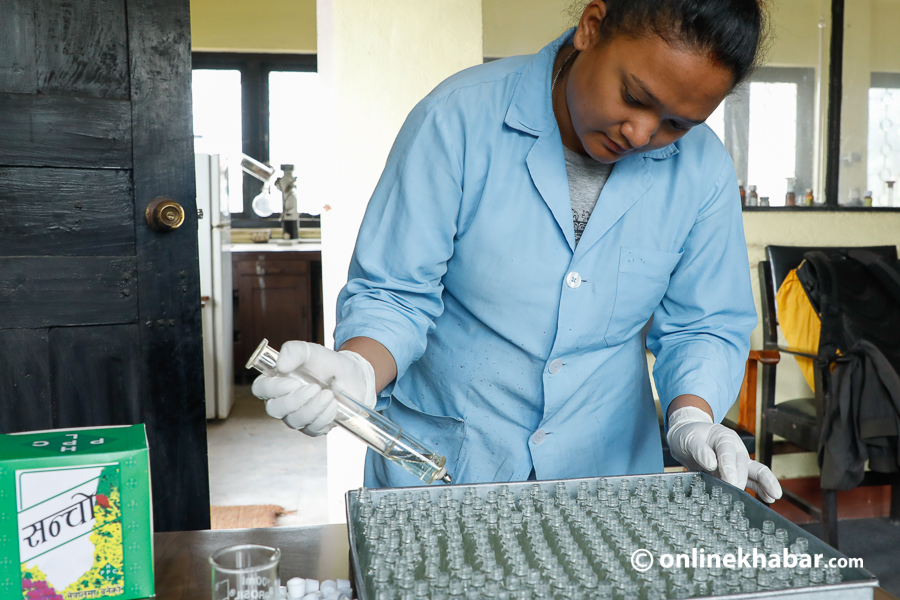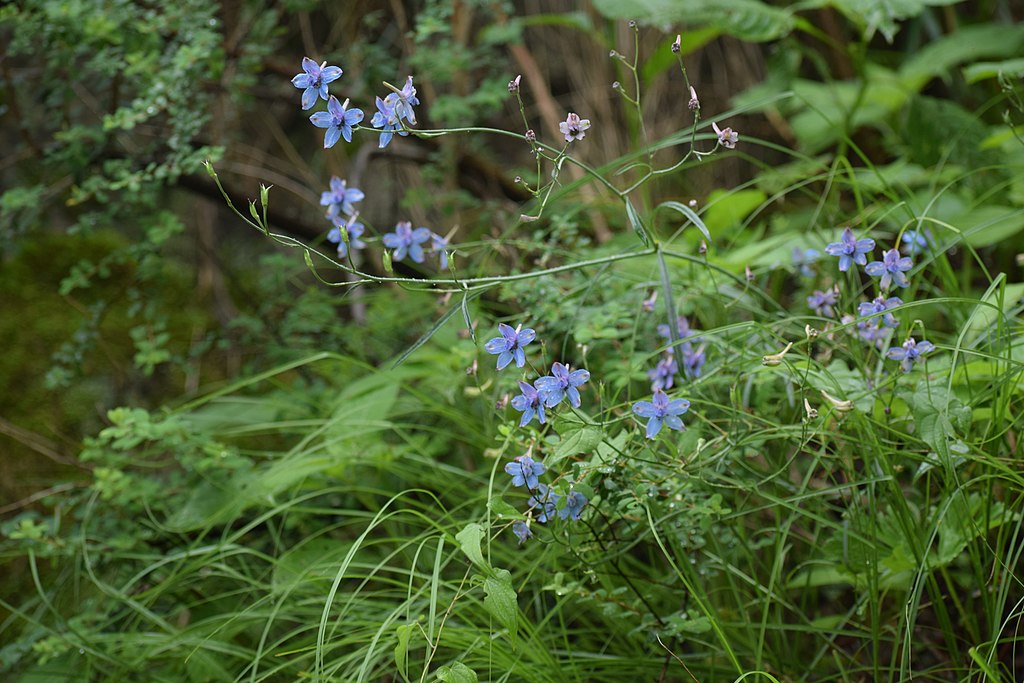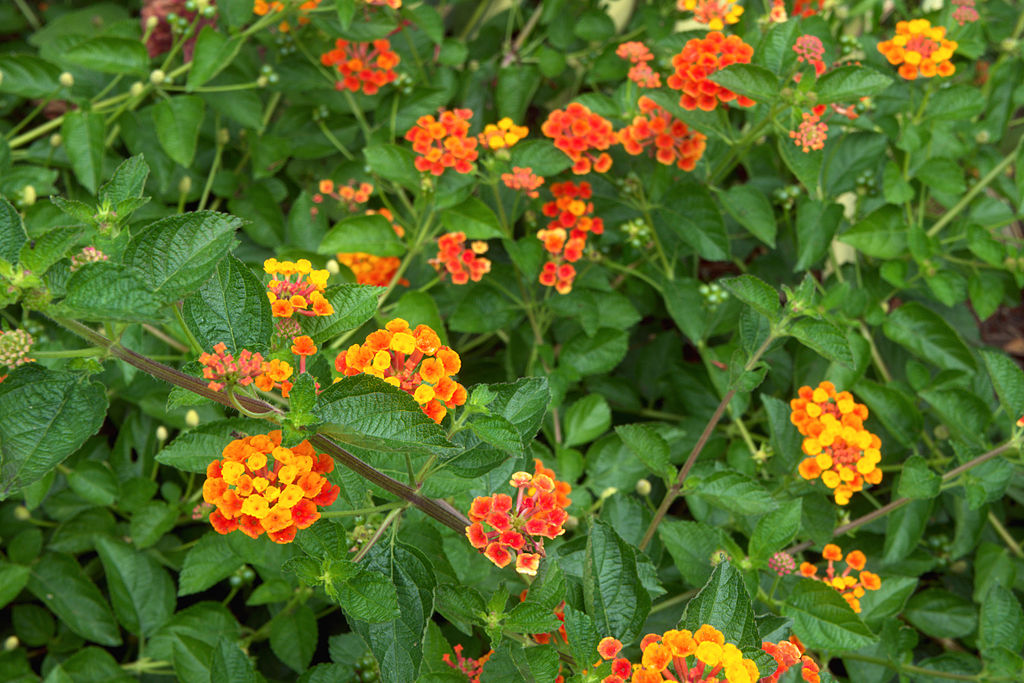Gyatso Bista, a resident of Lomanthang in the Upper Mustang region of northern Nepal, works as an amchi in his village. In traditional communities of Nepal’s Himalayan region, amchis are life-savers as medical doctors are not readily available there. They collect locally available medicinal plants, mix them to prepare medicines and prescribe them to the patients. A teenage Bista learned this traditional knowledge from his father and began practising at 18.
Now, 46 years down the line, Bista is living the same daily routine: visiting nearby grasslands, collecting herbs to prepare medicines and prescribing them to his patients. “A lot of things have changed over the years,” the 64-year-old man says over the phone from his village in Mustang, “Working as an amchi is not as easy as it used to be.”
One of the difficulties he highlights is the shrinking availability of herbs. “The grasses that used to be easily found have turned rare now. For a few species, finding a single blade of grass during an entire season is quite difficult.” He says unpredictable weather patterns are responsible for the change.
Experts say Nepal has over 2,000 species of medicinal plants, but only a few hundreds have been properly utilised for practical and commercial use. While efforts to cash in on the unexplored potential are scarce, new threats including climate change and the expansion of invasive species have endangered the medicinal plants’ biodiversity richness.
Unexplored potential

A 2007 survey by Manish Raj Pandey of the Annapurna Area Conservation Project lists 93 medicinal plants being used by amchis of Nepal’s Himalayan region. But, the number of medicinal plants available in Nepal is far more than this, according to researchers.
Tribhuvan University Central Department of Botany’s former chief Krishna Kumar Shrestha says around 2,000 plant species in Nepal are believed to possess medicinal properties. Yet, a publication by the government’s Department of Plant Resources mentions only 819 medicinal plants detected in Nepal. Moreover, only around 100 such plants are actively traded, informs the department chief Buddhi Sagar Poudel.
These gaps are evidence of the country’s failure to explore and exploit the potential that the medicinal plants have promised, says senior botanist Shrestha, who also leads a research NGO named Ethnobotanical Society of Nepal.
“This is a field where we have a comparative advantage. Also, indigenous people here have traditional knowledge about the use of medicinal plants in Nepal,” Poudel says, “But, we have not been able to convert them into trade and export opportunities so that it can be a vehicle to our nation’s prosperity.”
Despite leading a key government authority responsible to develop the sector, Poudel blames a lack of coordination among several stakeholders and limited investments, partly owing to the private sector’s apathy, for the failure to exploit the available resources.
“Even today, around 80 per cent of the herbs collected for trade and consumption are collected from the wild,” he says, “But if we want to make it sustainable, we need to begin farming.”
Climate change concerns

While officials and experts express concerns about the nation’s failure to commercialise the farming of medicinal plants, people directly involved in their collection have another more important and immediate issue to address: climate change.
“Thanks to global warming, our mountains are melting and the level of snow is coming down,” Amchi Gyatso Bista informs from his home in Mustang, “It has an impact on the vegetation of the area. Medicinal plants that used to grow above the altitude of 4,800 metres have not grown well as the climate today is not as cold as it should have been.”
Shanta Bahadur Jethara, a local from the Lekhgaun village in Humla, agrees with the amchi. According to him, a lack of timely and regular rainfall has given a blow to the medicinal plants in his area.
In his village, locals organise themselves in a group and go to the grasslands and forests to collect medicinal plants found in different seasons. “Around 10 or 15 years ago, each of these group members would bring a big packet of nirmasi (Delphinium denudatum) flowers, leaves and stems–all of which can be used as medicines–every week in the monsoon. But, these days, they just find a few in this period.”
Researcher Swastika Acharya, who chronicled different impacts of climate change on the medicinal plants in Nepal in February this year as a part of her academic study, says the impacts can be seen in the plants’ quality, productivity, and chemical efficiency.
“Whereas the amount of available resources goes down, the available resources might also be losing the efficiency in healing the patients. Their medicinal property grows less potent,” Acharya says, “Moreover, they will also have an impact on other species that will co-exist in nature regardless of whether they are medicinal or not.”
Yet, there can be some positive effects too. A study conducted by Ram Asheshwar Mandal and his students in the Humla district found that the production of Delphinium himalayai (locally known as atis) decreased with the increased temperature, but the production of Nardostachy grandiflora (locally known as jatamasi) was excessively high during the same period. Nonetheless, citing the data of the District Forests Office, the report says the overall production is on a decreasing trend.
“Climate change causes unpredictable weather patterns, and it means the production of medicinal plants will also turn unpredictable,” Mandal says, “Hence, it is a serious concern.”
Hidden yet heinous

Nepali researchers have identified a direct link between climate change and the expansion of invasive species. However, there has not been sufficient research on how invasive species are impacting the diversity of medicinal plants here.
“The invasive species have dominated biodiversity in many places of the country. It means it has some impact on medicinal plants also,” botanist Krishna Kumar Shrestha says, “Nonetheless, most of these herbal plants are available in highlands, where the invasive plants are not present in significant numbers.”
Yet, there are warnings that the highlands are under threat. Mandal says that he has recently observed that invasive plants such as Lantana camara have already reached the grasslands of highlands.
“In addition, low and mid-elevation regions also have a large number of medicinal plants, and they are likely to be affected by invasive species,” Bharat Babu Shrestha, a botanist at the Tribhuvan University, says.
Therefore, researcher Swastika Acharya says the impact of invasive species on medical plants is already evident. “They are one of the biggest causes of biological pollution. Based on the impact on other types of species, we can say they also cause a decrease in the efficiency of medicinal plants.”
“Unless proactive measures are implemented, mountains and medicinal plants [growing] there are no longer safe from invasive species,” says Bharat Babu Shrestha.
Yet, all researchers agree that no specific research has been conducted about the impact of invasive species on medicinal plants in Nepal, suggesting it should be their next focus.
Hopes for the future

Preserving and promoting medicinal plants available in Nepal fall under the mandates of several government agencies including the Department of Plant Resources. The department has launched some initiatives such as issuing standard procedures for the collection of key herbs and establishing a seed bank of endangered plants.
However, the department head Buddhi Sagar Poudel says it has failed to connect such initiatives with the impact of climate change and invasive species. “We have enough policies, but we lack concrete programmes and enough budget to implement them.”
In addition, the government has established Herbs Production and Processing Company Ltd (HPPCL) to capitalise on the medicinal plants available in Nepal. But, its work has been limited to cultivating six plants and manufacturing 15 products. Senior botanist Krishna Kumar Shrestha says, “The company should have expanded its scope across the nation and worked in the research and development sector also. But, it has not been as efficient as it could have been.”
The HPPCL General Manager Sangita Yadav agrees and has been lobbying government agencies to expand their work in this area. “Because we are market-oriented, we should now focus on product diversification and market expansion,” she says. Yadav, who was only recently appointed to head the Company, says she is hopeful that its reach and effectiveness will improve in her term.
Local governments heavily empowered by the 2015 constitution also have a role in protecting medicinal plants from climate change and other risks. Amchi Gyatso Bista from Mustang says he has been lobbying local government officials to prioritise the protection of these valuable resources and the rich traditional knowledge associated with them.
But, Humla’s Shanta Bahadur Jethara is not hopeful. “We know Humla is rich, but the people here are poor just because of the inefficiency of local governments. The officials don’t want to include us in their priority.”
The fate of these invaluable resources hangs in the balance between Bista’s hopes and Jethara’s fears.
—
This story was produced as a part of a reporting fellowship to the 2022 UN Convention on Biological Diversity’s 4th Meeting of the Open-ended Working Group on the Post-2020 Global Biodiversity Framework, led by Internews’ Earth Journalism Network.


























